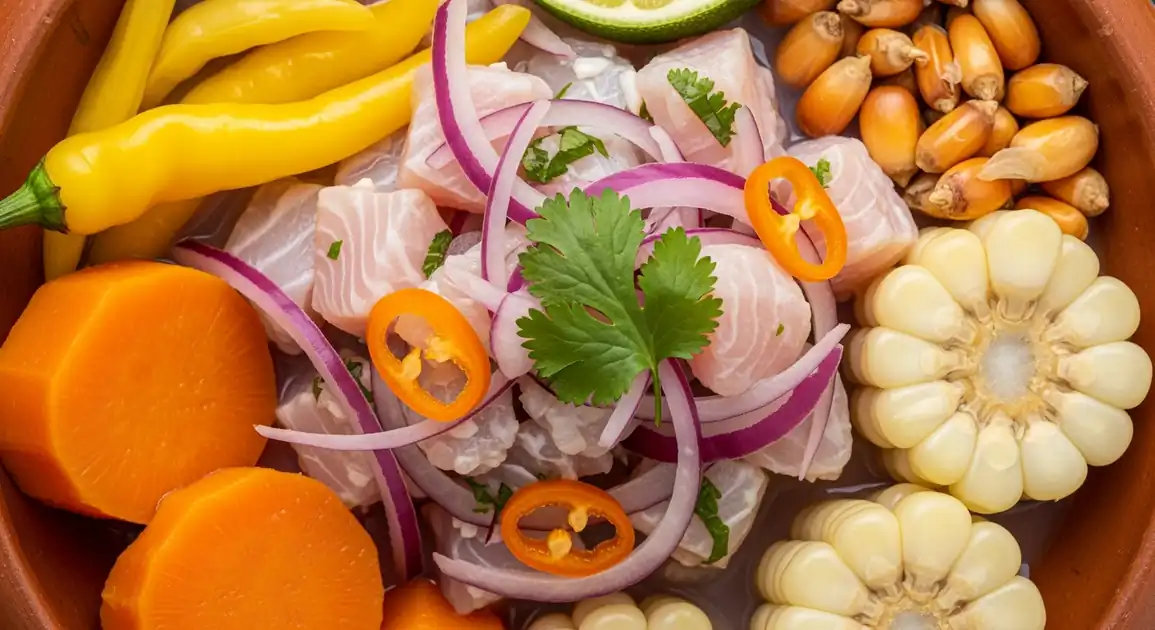Trout Ceviche
Ceviche de Trucha

Description
Ceviche is Peru's national dish, with the trout variation gaining particular popularity in the Andean highlands where freshwater trout is abundant. While coastal Peru focuses on ocean fish and seafood for ceviche, the mountain regions have developed their own interpretations using local trout, adapting this iconic dish to available resources.
Dietary Information
Serving information
Serving style
Served cold in a shallow bowl or plate, often with the sides (sweet potato, choclo corn, cancha) arranged alongside or beneath the marinated fish. Some restaurants serve the leche de tigre (marinade) in a separate shot glass.
Quick facts
Most traditional cevicherías operate from around 11 AM - 5 PM, with peak freshness and selection at lunch time.
Safety Tips
What to Look For
-
Fish that appears translucent or slightly opaque, never dull or gray
Properly 'cooked' trout in lime juice should have a consistent, fresh appearance throughout each piece.
-
Restaurants with visible refrigeration for fish storage
Proper cold chain management is essential for raw fish safety - look for display cases or clear indicators of refrigeration.
-
Ceviche prepared to order ('al momento')
The best establishments make ceviche fresh when ordered, not in large batches sitting for hours.
-
Clean preparation areas with staff using gloves or proper utensils
Observe the kitchen (if visible) or preparation areas for cleanliness and proper food handling techniques.
-
Restaurants that can tell you when their fish was delivered
Quality establishments know their supply chain and should be able to confirm the trout is same-day or very recent.
What to avoid
-
Fishy or ammonia smell
Fresh fish should smell clean and oceanic - any strong fish odor indicates deterioration.
-
Pre-made ceviche sitting at room temperature
Ceviche should always be refrigerated until serving and made relatively recently.
-
Mushy or falling apart fish texture
This indicates either poor-quality fish or improper handling/over-marination.
-
Very cheap ceviche from street vendors without proper refrigeration
While street food is generally wonderful in Peru, raw fish requires special handling and refrigeration.
-
Cloudy, murky, or discolored marinade liquid
The leche de tigre (marinade) should be relatively clear or slightly cloudy, never murky or discolored.
Price information
Price range
Budget tips
- Local 'menú' restaurants (offering fixed-price meals) often include ceviche as a starter for 15-25 PEN.
- Lunch specials (12 PM - 3 PM) typically offer better prices than dinner.
- Avoid tourist-trap restaurants with multi-language menus and touts outside - they charge more for lower quality.
- Markets like San Pedro in Cusco sometimes offer more affordable ceviche from food stalls.
Value indicators
- Freshly prepared to order ('al momento').
- Generous portion of fish (not mostly onions).
- Quality accompaniments (fresh choclo, properly cooked sweet potato).
- Complexity in the leche de tigre marinade (balanced flavors, not just sour).
Where to Find This Dish
Market Areas
Some local markets have dedicated ceviche sections, especially in the morning to early afternoon.
Central Markets, Fresh Fish Sections
Morning, Early Afternoon
Restaurant Districts
Areas with concentrations of traditional restaurants and picanterías.
Local Restaurant Rows, Food Courts
Lunch (12 PM - 3 PM)
Tourist Areas
Modified, often milder versions catering to international tourists.
Main Plazas, Tourist Corridors
Late Morning through Afternoon
Vendor Tips
- Ask when the fish was delivered - quality places receive fresh fish daily.
- Consider establishments where locals eat, not just tourists.
- Look for restaurants specializing in ceviche rather than places with extensive international menus.
How to Order
Regional Variations
-
Traditional Trout Ceviche
(Ceviche de Trucha Clásico)
The standard preparation with lime juice, red onions, cilantro, and aji limo or rocoto chile peppers.
-
Creamy Trout Ceviche
(Ceviche de Trucha Cremoso)
Incorporates a small amount of evaporated milk or cream into the marinade for a smoother, less acidic flavor profile.
-
Mountain-Style Trout Ceviche
(Ceviche de Trucha Andino)
Features local Andean herbs like huacatay (black mint) and regional chile varieties for a distinctive highland flavor.
-
Tiradito de Trucha
(Tiradito de Trucha)
Japanese-influenced version with thinly sliced trout (not cubed) and no onions, often with a more sauce-like marinade.
-
Mixed Ceviche with Trout
(Ceviche Mixto con Trucha)
Combines trout with other seafood or freshwater fish, offering varied textures and flavors in one dish.
Cultural context
History
While coastal ceviche dates back centuries in Peru, the Andean trout variation emerged more recently as transportation improved and tourism developed in the highlands. Trout was introduced to Peru's Andean lakes in the 1930s and has since become an important regional ingredient. Ceviche de Trucha represents the adaptive nature of Peruvian cuisine, applying coastal techniques to highland ingredients, and has become particularly popular in tourist centers like Cusco where visitors seek out Peru's national dish while in the mountains.
Local significance
Ceviche is Peru's national dish and source of culinary pride. While coastal versions are more traditional, the trout adaptation represents the innovative spirit of Peruvian cuisine and the country's diverse regional ingredients.
Eating customs
- Start by trying the leche de tigre (marinade) separately.
- It's acceptable to add additional lime or hot sauce to taste.
- Eat relatively quickly once served - ceviche doesn't improve with sitting time.